Carpathian Ruthenia is a historical region on the border between Central and Eastern Europe, mostly located in western Ukraine's Zakarpattia Oblast, with smaller parts in eastern Slovakia and the Lemko Region in Poland.
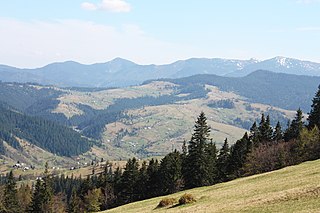
Zakarpattia Oblast, also referred to as simply Zakarpattia or Transcarpathia in English, is an oblast in western Ukraine, mostly coterminous with the historical region of Carpathian Ruthenia. Its administrative centre is the city of Uzhhorod. Other major cities within the oblast include Mukachevo, Khust, Berehove, and Chop, the last of which is home to railroad transport infrastructure.

Uzhhorod is a city and municipality on the Uzh River in western Ukraine, at the border with Slovakia and near the border with Hungary. The city is approximately equidistant from the Baltic, the Adriatic and the Black Sea (650–690 km) making it the most inland city in this part of Europe. It is the administrative center of Zakarpattia Oblast (region), as well as the administrative center of Uzhhorod Raion (district) within the oblast. Population: 115,449.
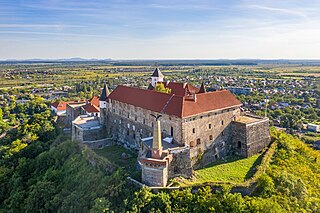
Mukachevo is a city in the valley of the Latorica river in Zakarpattia Oblast (province), in Western Ukraine serving as the administrative center of Mukachevo Raion (district). The city is a rail terminus and highway junction, and has beer, wine, tobacco, food, textile, timber, and furniture industries. During the Cold War, it was home to Mukachevo air base and a radar station.

Synagogue architecture often follows styles in vogue at the place and time of construction. There is no set blueprint for synagogues and the architectural shapes and interior designs of synagogues vary greatly. According to tradition, the Shekhinah or divine presence can be found wherever there is a minyan, a quorum, of ten. A synagogue always contains an Torah ark where the Torah scrolls are kept, called the aron qodesh by Ashkenazi Jews and the hekhal by Sephardic Jews.

Chop is a city located in Zakarpattia Oblast (province) of western Ukraine, near the borders of Slovakia and Hungary. It is separated from the Hungarian town of Záhony by the river Tisza by being situated on its right bank. It is located within Uzhhorod Raion. Today, the population is 8,626.

The Leopoldstädter Tempel was the largest synagogue of Vienna, in the district (Bezirk) of Leopoldstadt. It was also known as the Israelitische Bethaus in der Wiener Vorstadt Leopoldstadt. It was built in 1858 in a Moorish Revival style by the architect Ludwig Förster. The tripartite facade of the Leopoldstädter, with its tall central section flanked by lower wings on each side, became the model for numerous Moorish Revival synagogues, including the Choral Temple in Bucharest, which has an almost identical main facade, the Zagreb Synagogue, the Spanish Synagogue in Prague, the Tempel Synagogue in Kraków and the Grand Synagogue of Edirne.

Svaliava is a city located on the Latorytsia River in Zakarpattia Oblast in western Ukraine. It was the administrative center of the former Svaliava Raion (district) until 2020, but now it is in Mukachevo Raion. Population: 17,068.

Moorish Revival or Neo-Moorish is one of the exotic revival architectural styles that were adopted by architects of Europe and the Americas in the wake of Romanticist Orientalism. It reached the height of its popularity after the mid-19th century, part of a widening vocabulary of articulated decorative ornament drawn from historical sources beyond familiar classical and Gothic modes. Neo-Moorish architecture drew on elements from classic Moorish architecture and, as a result, from the wider Islamic architecture.

Perechyn is a city in Zakarpattia Oblast, Ukraine. It was the administrative centre of the former Perechyn Raion (district). It is now part of the Uzhhorod Raion. Today the population is 6,477.

The Jewish Museum of Florida-FIU is located in two restored historic buildings that were formerly synagogues, at 301 & 311 Washington Ave., in Miami Beach, Florida. The main museum building, at 301 Washington Ave., was built in 1936, is on the National Register of Historic Places, has Art Deco features, a copper dome, a marble bimah and 80 stained glass windows. The adjacent building located at 311 Washington, which served as Miami Beach's first synagogue, was purchased by the museum in 2005 and restored in 2007 as a museum expansion.

The Central Synagogue is a Reform Jewish congregation and synagogue at 652 Lexington Avenue, at the corner of East 55th Street in the Midtown Manhattan neighborhood of New York City. Built from 1870 to 1872 and designed by Henry Fernbach in the Moorish Revival style, the synagogue was influenced by Budapest's Dohány Street Synagogue. It has been continuously used by a congregation for longer than any other in New York state, except Congregation Berith Sholom in Troy, and is among the oldest existing synagogue buildings in the United States.
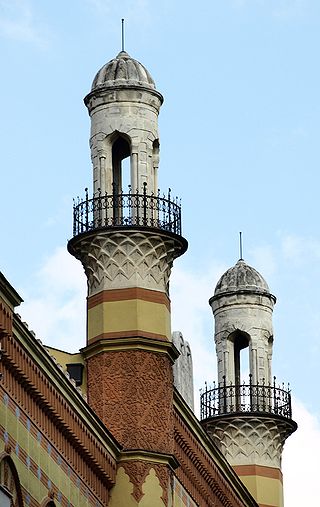
The Rumbach Street synagogue is located in Belváros, the inner city of the historical old town of Pest, in the eastern section of Budapest. The synagogue in Rumbach Street was built in 1872 to the design of the Viennese architect Otto Wagner. Intentionally meant to serve the members of the Neológ community of Pest, its construction coincided with the Schism in Hungarian Jewry of 1869, and it became the home of the more conservative Status Quo faction.

Temple Beth-El is an historic Reform Jewish former synagogue located at 208 South 15th Street in Corsicana, Navarro County, Texas, in the United States. Operating as a synagogue between 1898 and 1980, the exotic Moorish Revival-style building has been used as a community center since 1990.
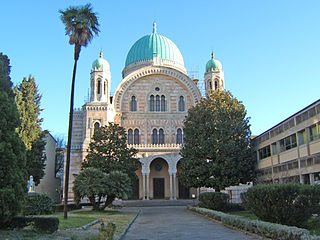
The Great Synagogue of Florence is one of the largest synagogues in South-central Europe, situated in Florence, in Italy. The synagogue of Florence was one of the most important synagogues built in Europe in the age of the Jewish emancipation, reached by the Jewish communities living in the Grand Duchy of Tuscany in 1848.

The Spanish Synagogue is the newest synagogue in the area of the so-called Jewish Town; it was in fact built at the site of the presumably oldest synagogue, Old School. The synagogue is built in Moorish Revival Style. Only a little park with a modern statue of Franz Kafka lies between it and the Church of the Holy Spirit. Today, the Spanish Synagogue is administered by the Jewish Museum in Prague.

The modern bilateral relationship between Hungary and Ukraine formally began in the early 1990s, after the end of communism in Hungary in 1989 and Ukrainian independence from the Soviet Union in 1991. Since then, the relationship has been marred by controversy over the rights of the Hungarian minority in the western Ukrainian region of Zakarpattia, where 150,000 ethnic Hungarians reside. Hungary and Ukraine have embassies in Kyiv and Budapest, respectively, as well as consulates in regions with large minority populations.

Serhiy Mykolayovych Ratushnyak is a former long-term Mayor of Uzhhorod, former People's Deputy of Ukraine and he was a self-nominated candidate in the 2010 Ukrainian presidential election. During the election Ratushnyak received 0.12% of the votes.

The New Synagogue in Ostrów Wielkopolski, Poland, is located in the city's center on 21 Raszkowska Street, which was the northern edge of the former Jewish district. Currently, this is the only preserved metropolitan synagogue. It is built in the once very popular Moorish Revival style. It is the most precious monument of religious architecture in Ostrów Wielkopolski. Long neglected, the synagogue has been fully restored in 2010. See the municipal website for updates:
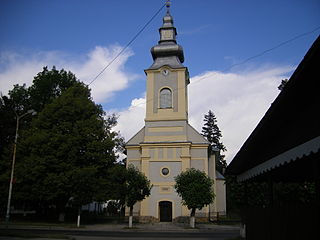
Velykyi Bereznyi is an urban-type settlement in Uzhhorod Raion, Zakarpattia Oblast, western Ukraine. The settlement was formerly the administrative center of Velykyi Bereznyi Raion, housing the district's local administration buildings until the raion's abolition, and is now administered within Uzhhorod Raion. The settlement's population was 6,655 as of the 2001 Ukrainian Census and 7,078 in 2011. Current population: 7,713.



























